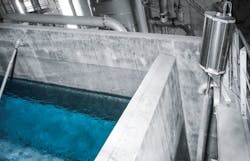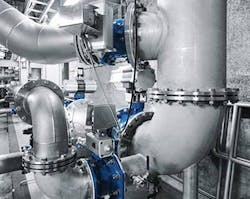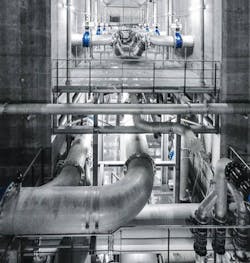Pneumatic Automation Upgrade
German water supply company Landeswasserversorgung saved 10% on investment and operating costs by upgrading to a pneumatic automation solution for a new groundwater filtration system.
By Craig Correia
Landeswasserversorgung Water Supply is one of the largest water supply and treatment companies in Germany and provides safe drinking water to approximately three million customers, which includes more than 250 cities and communities in Baden-Württemberg and Bavaria. The utility manages two waterworks in Langenau and Dischingen, as well as water mains system with an approximate length of 490 miles (790 km). The amount of water supplied can reach 450,000 m3/day.
Just over 50 years ago strong demand for groundwater was beginning to exceed capacity and the company looked at the possibility of using water from the Danube river to supplement supply. The Langenau waterworks went online in 1973. Today, the plant extracts 44.5 million cubic metres of water from the Danube, which equates to 1% of the river’s volume. The Langenau facility uses a six stage treatment process and recently the facility underwent a major renovation focusing on pneumatics rather than electrics.
Controlling the water flow
Water flow is controlled using pneumatic valve actuators and process valves for regulation and shut-off as well as for preventing return flow. The water supply company installed seven open two-tier filters in the new ground water filtration system at the Langenau water treatment plant. Here, the water flows first through a multi-media filter and then through an activated carbon filter.
During backwashing of one multi-media filter, the pipelines are opened and closed by 10 shut-off valves. These valves are actuated by pneumatic quarter turn actuators DAPS. They have an adjustable swivel angle, are compact and have torque characteristics that are suitable for process valves. The torque is generated via a scotch yoke mechanism which helps to overcome the valve’s high breakaway torques.
Complete pneumatic control circuit
The actuators are controlled by valve terminals CPX-VTSA with PROFINET connection. The valve terminals pick up all the signals from the filters, including feedback from actuators, pressure, temperature or fill level. The required flow for each valve position can be precisely set meaning the valve terminal saves energy.
In addition, a pneumatic linear actuator DFPI regulates the laterally mounted sludge water valves. A crucial feature of this is the integration of the displacement encoder in the actuator, which protects it from harsh environmental influences, enhances running performance and reduces maintenance costs. The pneumatic automation solution was rounded off with ready-to-install control cabinets and with all the accessories needed for the pneumatic control circuits, such as air preparation, tubing and fittings. Overall, the solution saved Landeswasserversorgung 10% on their investment and operating costs compared to electric automation.
Benefits of pneumatics
The water supply company benefited from the many advantages of pneumatics in process automation. Pneumatic components are resistant to continuous loads and maintenance-free over their entire service life.
They are very easy to install and are cheaper than comparable electrical solutions, particularly when implementing complete system solutions. Pneumatic components also have benefits when it comes to safety. Compressed air continues to be available even during a power failure. An air reservoir is always available along with a compressor for generation and preparation purposes.
Apart from end-position sensing and monitoring the compressed air supply, it doesn’t need to be monitored and checked. It follows the “fit and forget” principle.
Durable technology
Pneumatic actuators have proven to be shock-proof and durable and are also resistant to continuous loads and remain maintenance-free over their entire service life. There is no need for oil changes or additional lubrication.
Pneumatic actuators only require electricity for the control and generation of compressed air; the movement itself is triggered by the compressed air. Whereas electric actuators require gearboxes, which are responsible for most of the power losses as well as electrical heat losses, pneumatic actuators act directly on the shut-off device. They only require a piston and drive shaft to convert the “linear” compressed air force into a swivel motion.
Since pneumatic actuators are overload-proof and a higher actuation force can be achieved very simply by increasing the pressure, it is often possible to use smaller sizes with a lower weight than would be the case for electric actuators. Provided the tubing has zero leakage and the units are precisely dimensioned, the resulting solutions are energy-efficient.
Small sizes were also advantageous for the Langenau water treatment plant.The low costs mean that it is even worthwhile automating manual process valves at a later date. Specifically when compared to electric drive technology, the consistent use of decentralised automation concepts with valve terminals provides significant cost benefits - in the case of the Langenau water treatment plant, this meant savings of 10%. Some projects have even seen savings of more than 50%.
Craig Correia is head of process automation at pneumatic and electrical automation technology company, Festo.
More Water & WasteWater International Archives Issue Articles



